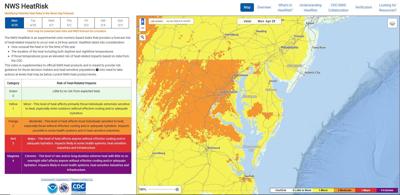DELMARVA - The National Oceanic and Atmospheric Administration’s National Weather Service (NWS) in collaboration with the Centers for Disease Control and Prevention (CDC) recently released a new experimental heat tool called HeatRisk. HeatRisk will not replace the current NWS heat watch and warning products, but will be a new tool to help identify when heat could cause problems for people's health.
This new tool is arriving just in time for the first taste of summer here on Delmarva. Temperatures today will approach 90 degrees in many inland locations. Historically, our first 90 degree day on average occurs around May 25th.
HeatRisk takes into account this historical context when identifying how unusual heat will be for any given area allowing for high resolution mapping of where heat health risks will be the highest. This tool also takes into account the cumulative impacts of heat. Heat historically is one of the most dangerous weather phenomenon.
"Did you know that extreme heat kills more people in the U.S. today than any other weather hazard, that includes hurricanes, floods, and tornadoes. Our friends and colleagues at the Center for Disease Control and Prevention estimates over 1,200 people die from heat-related causes in the U.S. annually," explained Dr. Rick Spinrad, NOAA's Administrator.
Today parts of Delmarva are in the Category 2 or Orange heat risk.
This new heat tool breaks down heat into 5 different categories:
-Code Green/0= Little or no risk from heat
-Code Yellow/1=Minor impacts/Health risks to those people extremely sensitive to heat, especially those outside with little access to effective cooling or hydration
-Code Orange/2=Moderate impacts/Health risks to most individuals sensitive to heat. Impacts are possibly felt in some health systems and in heat-sensitive industries
-Code Red/3=Major impacts/Health risks to all people without effective cooling or hydration. Impacts are likely felt in some health systems, heat-sensitive industries, and infrastructure
-Code Magenta/4=Extreme impacts/Rare long-duration extreme heat that impacts everyone without effective cooling or hydration. Impacts are likely felt in most health systems, heat-sensitive industries, and infrastructure
HeatRisk will be used to forecast health risks related to heat all the way out to 7 days. This will allow people and communities to prepare for incoming heat days in advance.
You can access this new HeatRisk tool here.







